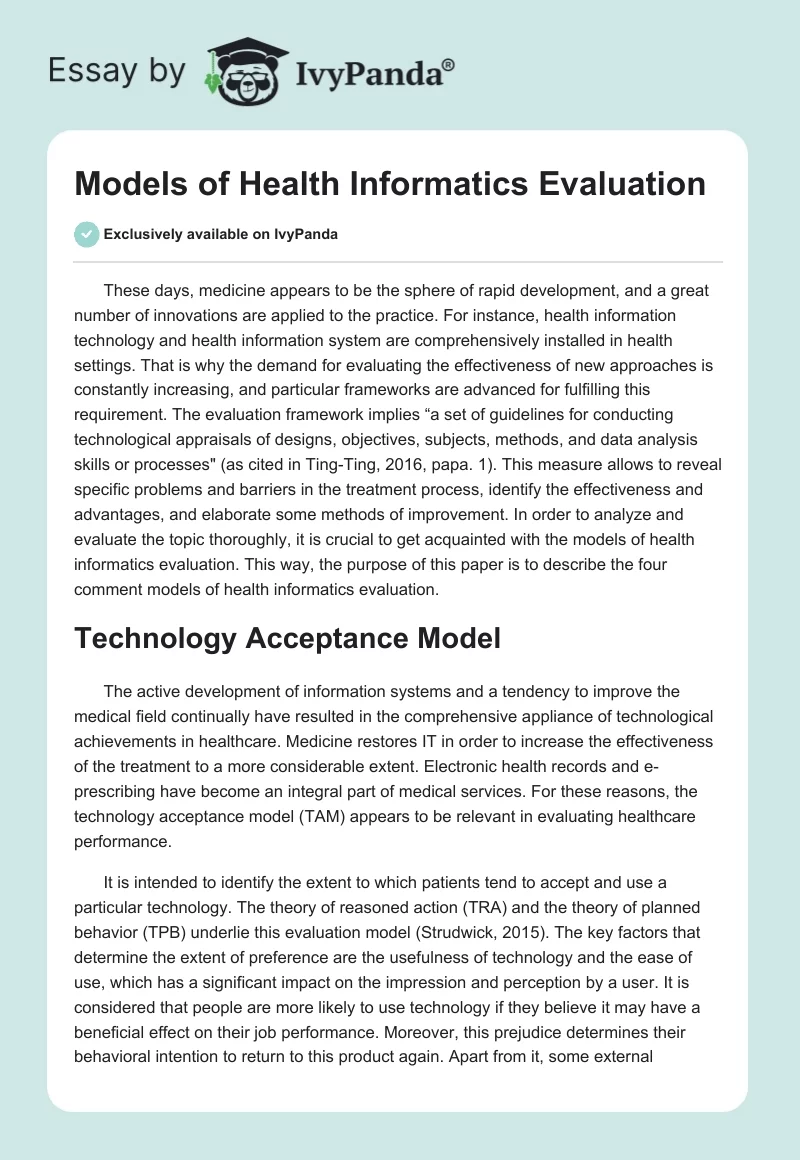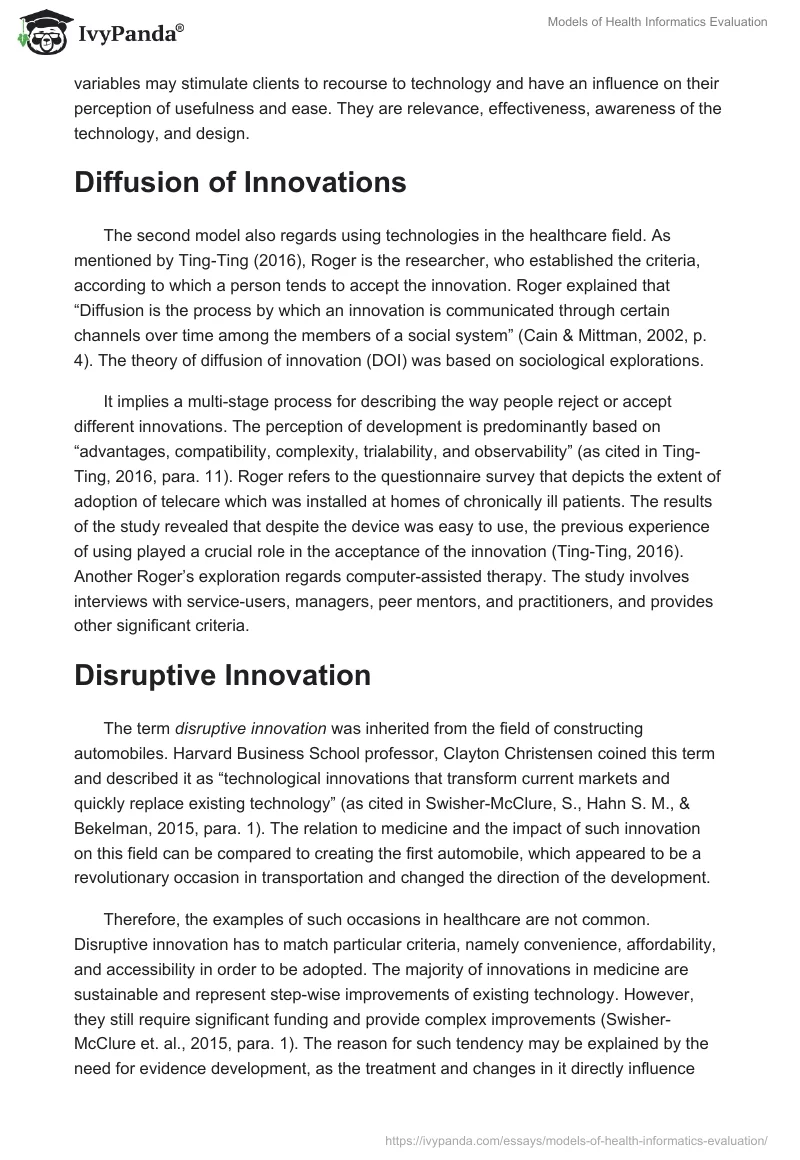These days, medicine appears to be the sphere of rapid development, and a great number of innovations are applied to the practice. For instance, health information technology and health information system are comprehensively installed in health settings. That is why the demand for evaluating the effectiveness of new approaches is constantly increasing, and particular frameworks are advanced for fulfilling this requirement. The evaluation framework implies “a set of guidelines for conducting technological appraisals of designs, objectives, subjects, methods, and data analysis skills or processes” (as cited in Ting-Ting, 2016, papa. 1). This measure allows to reveal specific problems and barriers in the treatment process, identify the effectiveness and advantages, and elaborate some methods of improvement. In order to analyze and evaluate the topic thoroughly, it is crucial to get acquainted with the models of health informatics evaluation. This way, the purpose of this paper is to describe the four comment models of health informatics evaluation.
Technology Acceptance Model
The active development of information systems and a tendency to improve the medical field continually have resulted in the comprehensive appliance of technological achievements in healthcare. Medicine restores IT in order to increase the effectiveness of the treatment to a more considerable extent. Electronic health records and e-prescribing have become an integral part of medical services. For these reasons, the technology acceptance model (TAM) appears to be relevant in evaluating healthcare performance.
It is intended to identify the extent to which patients tend to accept and use a particular technology. The theory of reasoned action (TRA) and the theory of planned behavior (TPB) underlie this evaluation model (Strudwick, 2015). The key factors that determine the extent of preference are the usefulness of technology and the ease of use, which has a significant impact on the impression and perception by a user. It is considered that people are more likely to use technology if they believe it may have a beneficial effect on their job performance. Moreover, this prejudice determines their behavioral intention to return to this product again. Apart from it, some external variables may stimulate clients to recourse to technology and have an influence on their perception of usefulness and ease. They are relevance, effectiveness, awareness of the technology, and design.
Diffusion of Innovations
The second model also regards using technologies in the healthcare field. As mentioned by Ting-Ting (2016), Roger is the researcher, who established the criteria, according to which a person tends to accept the innovation. Roger explained that “Diffusion is the process by which an innovation is communicated through certain channels over time among the members of a social system” (Cain & Mittman, 2002, p. 4). The theory of diffusion of innovation (DOI) was based on sociological explorations.
It implies a multi-stage process for describing the way people reject or accept different innovations. The perception of development is predominantly based on “advantages, compatibility, complexity, trialability, and observability” (as cited in Ting-Ting, 2016, para. 11). Roger refers to the questionnaire survey that depicts the extent of adoption of telecare which was installed at homes of chronically ill patients. The results of the study revealed that despite the device was easy to use, the previous experience of using played a crucial role in the acceptance of the innovation (Ting-Ting, 2016). Another Roger’s exploration regards computer-assisted therapy. The study involves interviews with service-users, managers, peer mentors, and practitioners, and provides other significant criteria.
Disruptive Innovation
The term disruptive innovation was inherited from the field of constructing automobiles. Harvard Business School professor, Clayton Christensen coined this term and described it as “technological innovations that transform current markets and quickly replace existing technology” (as cited in Swisher-McClure, S., Hahn S. M., & Bekelman, 2015, para. 1). The relation to medicine and the impact of such innovation on this field can be compared to creating the first automobile, which appeared to be a revolutionary occasion in transportation and changed the direction of the development.
Therefore, the examples of such occasions in healthcare are not common. Disruptive innovation has to match particular criteria, namely convenience, affordability, and accessibility in order to be adopted. The majority of innovations in medicine are sustainable and represent step-wise improvements of existing technology. However, they still require significant funding and provide complex improvements (Swisher-McClure et. al., 2015, para. 1). The reason for such tendency may be explained by the need for evidence development, as the treatment and changes in it directly influence patients’ health and the quality of life. This way, disruptive innovation should imply significant improvements and thorough preparations.
Sociotechnical Theory Models
The intensity of personal interactions appears to be a differentiating feature of the healthcare field, as it is impossible to supply patients with efficient treatment without conversating. Communicating is essential for revealing the symptoms, controlling the effectiveness of prescribed medicines, and conducting further services (Sittig & Singh, 2015). Consequently, applying Information and Communication Technologies (ICT) is an increasing tendency in the healthcare industry, as it is helpful in achieving such goals as better decision-making, cost-effectiveness, the quality of medical services, and data privacy.
Sociotechnical theory models are aimed at addressing identified problems and predominantly provide beneficial outcomes. These kinds of innovation are comprehensive and imply condition changes and contribute to a deeper understanding of ICT application development, introduction, and practice. The major aspect of this model is the fact that healthcare is analyzed form the sociotechnical perspective, and the main focus is directed to people and their performance (Sittig & Singh, 2015). In addition, these theories perceive technological innovation as a part of social progress. Therefore, this approach is sufficient for conducting system design improvements and implementations.
Conclusion
Elaborating improvements and advancing innovations are essential parts of the progress in the healthcare industry, that is why adopting and adjusting modern technological achievements to the treatment process present a matter of extreme importance. Technologies may contribute to the healing of a patient, as they help to optimize medical services and the extent of the accessibility. However, the process of adopting a new device is enduring, as it requires a comprehensive approach in order to avoid a negative impact on a patient’s health and quality of life. This way, there are specific models of health informatics evaluation that are helpful for the adoption of particular technologies and improve them for meeting the needs of patients.
For proposing an appropriate evaluation plan, sociotechnical theory models might be the most effective options of other ones. Healing regards not only prescribing the correct medicines and applying efficient treatment, but also cooperating with patients for monitoring their condition and preventing developing other diseases. It is impossible to determine the correct diagnosis and appropriate care plan without polite and understanding conversation, so, these theories might provide the highest results of applying new technologies in accordance with particular patients’ requirements.
References
Cain, M. & Mittman, R. (2002). Diffusion of innovation in health care[PDF document]. Web.
Sittig D.F. & Singh H. (2015). A new socio-technical model for studying health information technology in complex adaptive healthcare systems. In Cognitive informatics for biomedicine (pp. 59-80). Cham, Switzerland: Springer.
Strudwick, G. (2015). Predicting nurses’ use of healthcare technology using the technology acceptance model. CIN: Computers, Informatics, Nursing, 33(5), 189-198. Web.
Swisher-McClure, S., Hahn S. M., & Bekelman J. (2015). Proton beam therapy: the next disruptive innovation in healthcare. Postgraduate Medical Journal, 91, 241-243. Web.
Ting-Ting, L. (2016). Evaluation of health information technology – Key elements in the framework. The Journal of Nursing Research, 24(4), 283-285. Web.


